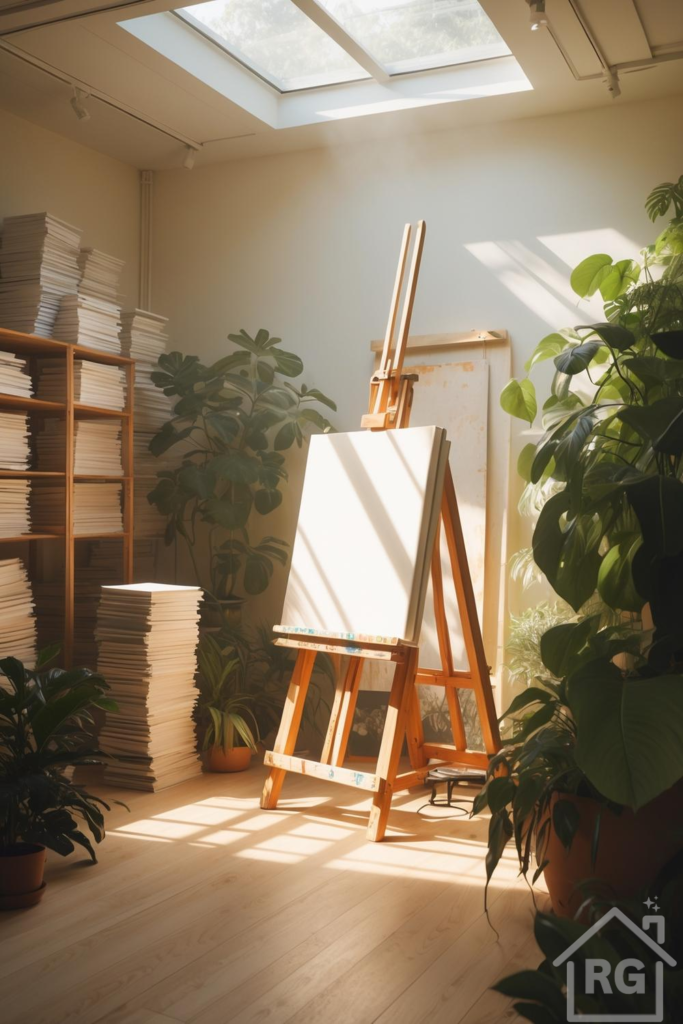
Every artist, whether professional or hobbyist, dreams of a dedicated space where creativity can flourish unhindered. Imagine a room bathed in gentle light, surrounded by the calming presence of nature, and organized to support your artistic journey. A bright, airy art studio, like the one pictured, perfectly encapsulates such a sanctuary – feeling both functional and deeply inspiring. This guide will break down the key elements that make such a space so captivating and offer practical tips for transforming your own corner into an artistic haven.
The Luminous Embrace of Natural Light
Perhaps the most striking feature of any inspiring art studio is its **abundant natural light**. A large skylight or generous windows act as a portal to the sky, allowing soft, diffused sunlight to flood the entire room. This isn’t just aesthetically pleasing; it’s fundamentally important for an artist.
Natural light provides the most accurate color rendition, crucial for painting, drawing, or any visual art form. It eliminates harsh shadows and creates a dynamic interplay of light and shade throughout the day, constantly shifting the mood of the space. The quality of light changes from the crisp, clear illumination of morning to the warm, golden glow of late afternoon, offering a diverse palette of natural conditions for an artist to work under. This constant, yet subtle, evolution of light can even inspire new perspectives and approaches to a piece.
Maximizing Your Studio’s Illumination:
- Skylights and Large Windows: If possible, incorporate these architectural features. They are unparalleled sources of overhead and ambient light, minimizing the need for artificial lighting during the day and reducing eye strain.
- Sheer Curtains or Blinds: If direct sunlight is too intense, use sheer white or off-white curtains or adjustable blinds to diffuse it without blocking it entirely. This helps to prevent glare and protect sensitive materials from fading.
- Light Wall Colors: As seen in many bright studios, light cream or off-white walls reflect light beautifully, making the room feel larger, brighter, and more open. These neutral tones also ensure that the colors of your artwork are perceived accurately, without interference from strong wall hues.
- Strategic Placement: Position your easel or primary workspace to take full advantage of the best light source. For painters, consistent, indirect light is often preferred to avoid harsh shadows on the canvas.
- Supplemental Lighting: While natural light is king, consider track lighting or adjustable task lamps with full-spectrum, daylight-balanced bulbs (around 5000K-6500K) for evening work or overcast days. These mimic natural light and are essential for maintaining color accuracy when the sun isn’t available.
The Calming Presence of Greenery
Lush, vibrant green plants are more than just decor; they introduce a vital element of nature into your studio, bringing life, freshness, and a sense of calm. From towering Monsteras to broad Fiddle Leaf Figs, these botanical companions can transform your creative environment.
Plants purify the air by absorbing toxins and releasing oxygen, reduce stress, and can even boost creativity by fostering a deeper connection to the natural world. Their varied textures and forms add visual interest and a soft, organic contrast to the clean lines of a studio, creating a truly harmonious space.
Integrating Plants into Your Creative Space:
- Choose Low-Maintenance Varieties: Opt for plants like Pothos, Snake Plants, ZZ Plants, or even the larger Monstera and Fiddle Leaf Fig if you have ample light. These are relatively forgiving and don’t demand constant attention, allowing you to focus on your art.
- Vary Sizes and Heights: Mix large floor plants that anchor a corner with smaller potted plants on shelves, windowsills, or tables to create visual interest, depth, and a layered look.
- Consider Plant Health: Ensure your chosen plants thrive in the specific light and humidity conditions of your studio. Healthy, thriving plants look best and offer the most benefits. Research their needs before bringing them home.
- Earthy Pots: Terracotta, simple ceramic, or woven baskets in neutral tones complement the natural aesthetic and keep the focus on the plants themselves, rather than distracting patterns or colors.
- Sensory Experience: Beyond their visual appeal, consider plants that offer subtle fragrances or unique textures, further engaging your senses and contributing to a holistic creative environment.
Warm Wood Tones and an Earthy Palette
The ideal art studio’s color palette is a masterclass in **understated elegance**, built upon a foundation of warm wood tones and soft, neutral walls. Elements like a light oak floor, a sturdy wooden easel, and practical shelving units all contribute a grounding, organic feel.
These natural wood elements introduce texture and warmth, preventing a bright, airy space from feeling cold or sterile. The subtle grain of the wood, catching the sunlight, adds a dynamic visual element that speaks to authenticity and craftsmanship. Walls painted in a soft, creamy off-white serve as the perfect neutral backdrop, allowing the vibrant greens of plants and the potential colors of an artist’s work to truly pop without competition. This deliberate choice of a calm, earthy palette creates a serene atmosphere conducive to deep concentration and imaginative exploration.
Crafting Your Studio’s Palette:
- Neutral Walls: Start with a base of white, off-white, cream, or a very light greige. These colors maximize light reflection and won’t interfere with your perception of colors while working, ensuring your artwork’s true hues are visible.
- Natural Materials: Incorporate wood (light or medium tones), rattan, bamboo, linen, cotton, or wool for furniture, storage, and textiles. These materials add warmth, texture, and a tactile quality that grounds the space.
- Accent Colors from Nature: Let your plants provide the main accent color. You can also introduce subtle hints of earthy browns, soft blues (like a clear sky), muted greens, or terracotta oranges through small decor items, pottery, or even your art supplies themselves.
- Embrace Imperfection: Natural materials often have slight variations, knots, and imperfections, which add character, authenticity, and a lived-in feel to the space, making it feel more inviting and less rigid.
- Consider the Floor: A light wood floor brightens the room and provides a seamless, easy-to-clean surface, ideal for an art studio where spills might occur.
Organization for Uninterrupted Creativity
While a studio should feel open and spacious, **organization plays a crucial role** in maintaining its serene ambiance. A tall wooden shelving unit, neatly stacked with canvases and papers, demonstrates a commitment to order. In an art studio, clutter can be a major distraction, hindering the creative flow and making it difficult to find what you need.
Having designated, accessible storage for all supplies, finished pieces, and works in progress ensures that everything has its place, allowing the artist to focus solely on their craft without the mental burden of disarray.
Tips for an Organized Studio:
- Vertical Storage: Utilize tall shelves, modular drawer units, or rolling carts to maximize vertical space, especially for items like large paper pads, canvases, sketchbooks, and reference materials.
- Clear Containers and Labels: Use clear bins, jars, or drawer organizers for smaller supplies like brushes, pencils, pastels, paints, and mediums. Labeling these containers can save valuable time during a creative session.
- Dedicated Zones: If space allows, create distinct zones for different activities – a painting area with your easel, a drawing desk, a drying rack for wet canvases, a clean area for framing, or a storage corner for bulk supplies.
- Regular Decluttering: Make it a habit to put things away after each session and periodically declutter unused, expired, or old supplies. A clean workspace promotes a clear mind.
- Accessible Tools: Keep frequently used tools and materials within easy reach, perhaps on a small side table next to your easel or in a rolling cart that can be moved as needed. Consider wall-mounted organizers for brushes or tools.
- Protect Your Work: Invest in flat files or portfolio cases for delicate papers and finished artworks to protect them from dust, light, and damage.
Essential Elements for the Artist
At the heart of any art studio stands a classic easel, ready for the next masterpiece. This fundamental piece of equipment is a testament to the room’s purpose. A blank canvas awaits, symbolizing potential and new beginnings, inviting the artist to fill it with vision. Beyond the easel, consider these other essentials that support your artistic practice and enhance your comfort and efficiency:
- Easel Type: Choose an easel that suits your medium and working style. H-frame easels offer stability for larger works, while A-frame easels are more compact. Tabletop easels are great for smaller pieces or limited space.
- Comfortable Seating: An adjustable stool or chair that supports good posture during long creative sessions is paramount. Ergonomics can prevent fatigue and allow for longer, more productive work periods.
- Water Source & Cleanup Station: Easy access to water for cleaning brushes, mixing paints, or even a small sink if possible. A dedicated cleanup area helps keep the rest of your studio tidy.
- Ventilation: Especially important if working with solvents, aerosols, or strong-smelling mediums. Ensure good airflow with open windows, a fan, or even an air purifier to maintain a healthy environment.
- Inspiration Board: A cork board, magnetic wall, or even a digital display where you can pin up reference images, color palettes, inspiring quotes, or sketches. This keeps your muse close at hand.
- Lighting for Detail: Beyond ambient light, consider a flexible task lamp with a daylight bulb for close-up work, ensuring you can see fine details clearly.
- Protection: Floor mats or drop cloths can protect your beautiful wooden floor from spills and drips, making cleanup much easier.
Cultivating a Flow State
Ultimately, the design of an art studio should be geared towards fostering a **”flow state”** – that deeply immersive and focused mental state where artists feel most productive, uninhibited, and connected to their work. The combination of ample natural light, the calming presence of plants, the grounding warmth of wood, and meticulous organization all contribute to an environment free from distraction and rich with inspiration. It’s a space that invites deep concentration, encourages spontaneous experimentation, and celebrates the pure, unadulterated act of creation.
When your environment is thoughtfully curated, it becomes an extension of your creative mind. The gentle hum of natural light, the subtle rustle of leaves, the smooth feel of wood underhand – these sensory inputs create a harmonious backdrop that allows your conscious mind to quiet down, making way for intuition and imagination to take over. A well-designed studio can reduce cognitive load, minimize external stressors, and provide a sense of sanctuary where time seems to melt away, and artistic possibilities feel limitless. It’s not just a room; it’s a sacred space where ideas are born and brought to life.
By intentionally designing your studio to support your unique creative process, you are investing in your artistic well-being. This means creating a space that feels personal, comfortable, and inspiring, allowing you to fully immerse yourself in your craft without interruption. Embrace the elements that resonate most with you, and watch as your productivity and joy in creating soar.
Conclusion
Creating an art studio that truly inspires is about more than just aesthetics; it’s about crafting an environment that nurtures your artistic spirit. By embracing natural light, integrating lush greenery, opting for warm, natural materials, and prioritizing smart organization, you can transform any space into a vibrant hub of creativity.
Let this guide be your blueprint for a space where ideas flow freely, colors sing, and every brushstroke feels like a step closer to your artistic vision. **Start building your dream studio today and unlock your full creative potential!**
